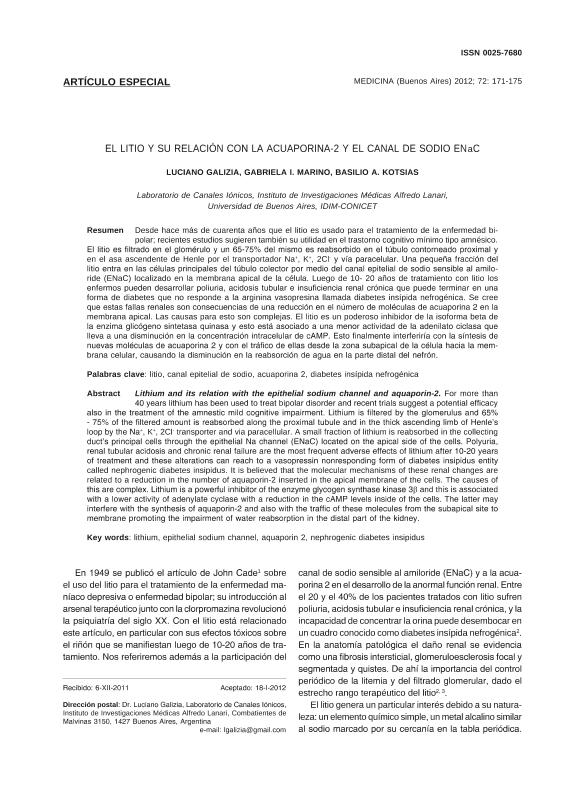Artículo
Desde hace más de cuarenta años que el litio es usado para el tratamiento de la enfermedad bipolar; recientes estudios sugieren también su utilidad en el trastorno cognitivo mínimo tipo amnésico. El litio es filtrado en el glomérulo y un 65-75% del mismo es reabsorbido en el túbulo contorneado proximal y en el asa ascendente de Henle por el transportador Na+, K+, 2Cl- y vía paracelular. Una pequeña fracción del litio entra en las células principales del túbulo colector por medio del canal epitelial de sodio sensible al amiloride (ENaC) localizado en la membrana apical de la célula. Luego de 10- 20 años de tratamiento con litio los enfermos pueden desarrollar poliuria, acidosis tubular e insuficiencia renal crónica que puede terminar en una forma de diabetes que no responde a la arginina vasopresina llamada diabetes insípida nefrogénica. Se cree que estas fallas renales son consecuencias de una reducción en el número de moléculas de acuaporina 2 en la membrana apical. Las causas para esto son complejas. El litio es un poderoso inhibidor de la isoforma beta de la enzima glicógeno sintetasa quinasa y esto está asociado a una menor actividad de la adenilato ciclasa que lleva a una disminución en la concentración intracelular de cAMP. Esto finalmente interferiría con la síntesis de nuevas moléculas de acuaporina 2 y con el tráfico de ellas desde la zona subapical de la célula hacia la membrana celular, causando la disminución en la reabsorción de agua en la parte distal del nefrón. For more than 40 years lithium has been used to treat bipolar disorder and recent trials suggest a potential efficacy also in the treatment of the amnestic mild cognitive impairment. Lithium is filtered by the glomerulus and 65% - 75% of the filtered amount is reabsorbed along the proximal tubule and in the thick ascending limb of Henle's loop by the Na+, K+, 2Cl- transporter and via paracellular. A small fraction of lithium is reabsorbed in the collecting duct's principal cells through the epithelial Na channel (ENaC) located on the apical side of the cells. Polyuria, renal tubular acidosis and chronic renal failure are the most frequent adverse effects of lithium after 10-20 years of treatment and these alterations can reach to a vasopressin nonresponding form of diabetes insipidus entity called nephrogenic diabetes insipidus. It is believed that the molecular mechanisms of these renal changes are related to a reduction in the number of aquaporin-2 inserted in the apical membrane of the cells. The causes of this are complex. Lithium is a powerful inhibitor of the enzyme glycogen synthase kinase 3β and this is associated with a lower activity of adenylate cyclase with a reduction in the cAMP levels inside of the cells. The latter may interfere with the synthesis of aquaporin-2 and also with the traffic of these molecules from the subapical site to membrane promoting the impairment of water reabsorption in the distal part of the kidney.
El litio y su relación con la acuaporina-2 y el canal de sodio ENaC
Título:
Lithium and its relation with the epithelial sodium channel and aquaporin-2
Fecha de publicación:
03/2012
Editorial:
Medicina (Buenos Aires)
Revista:
Medicina (Buenos Aires)
ISSN:
0076-6046
e-ISSN:
1669-9106
Idioma:
Español
Tipo de recurso:
Artículo publicado
Clasificación temática:
Resumen
Palabras clave:
Litio
,
Canal Epitelial de Sodio
,
Aquaporina 2
,
Diabetes Insípida Nefrogénica
Archivos asociados
Licencia
Identificadores
Colecciones
Articulos(IDIM)
Articulos de INST.DE INVEST.MEDICAS
Articulos de INST.DE INVEST.MEDICAS
Citación
Galizia, Luciano; Marino, Gabriela Inés; Kotsias, Basilio Aristides; El litio y su relación con la acuaporina-2 y el canal de sodio ENaC; Medicina (Buenos Aires); Medicina (Buenos Aires); 72; 2; 3-2012; 171-175
Compartir




